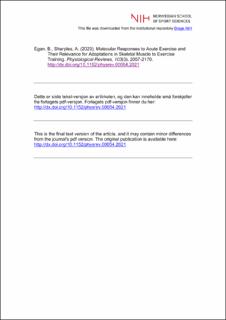| dc.contributor.author | Egan, Brendan | |
| dc.contributor.author | Sharples, Adam | |
| dc.date.accessioned | 2023-11-17T11:39:31Z | |
| dc.date.available | 2023-11-17T11:39:31Z | |
| dc.date.created | 2022-11-21T09:35:09Z | |
| dc.date.issued | 2022 | |
| dc.identifier.citation | Physiological Reviews. 2022, 103(3), 2057-2170. | en_US |
| dc.identifier.issn | 0031-9333 | |
| dc.identifier.uri | https://hdl.handle.net/11250/3103219 | |
| dc.description | I Brage finner du siste tekst-versjon av artikkelen, og den kan inneholde ubetydelige forskjeller fra forlagets pdf-versjon. Forlagets pdf-versjon finner du på journals.physiology.org / In Brage you'll find the final text version of the article, and it may contain insignificant differences from the journal's pdf version. The definitive version is available at journals.physiology.org | en_US |
| dc.description.abstract | Repeated, episodic bouts of skeletal muscle contraction undertaken frequently as structured exercise training is a potent stimulus for physiological adaptation in many organs. Specifically in skeletal muscle, remarkable plasticity is demonstrated by the remodeling of muscle structure and function in terms of muscular size, force, endurance, and contractile velocity as a result of the functional demands induced by various types of exercise training. This plasticity, and the mechanistic basis for adaptations to skeletal muscle in response to exercise training, is underpinned by activation and/or repression of molecular pathways and processes induced in response to each individual acute exercise session. These pathways include the transduction of signals arising from neuronal, mechanical, metabolic, and hormonal stimuli through complex signal transduction networks, which are linked to a myriad of effector proteins involved in the regulation of pre- and post-transcriptional processes, and protein translation and degradation processes. This review therefore describes acute exercise-induced signal transduction and the molecular responses to acute exercise in skeletal muscle including emerging concepts such as epigenetic pre- and post-transcriptional regulation, and the regulation of protein translation and degradation. A critical appraisal of methodological approaches and the current state of knowledge informs a series of recommendations offered as future directions in the field. | en_US |
| dc.language.iso | eng | en_US |
| dc.subject | aerobic | en_US |
| dc.subject | gene expression | en_US |
| dc.subject | metabolism | en_US |
| dc.subject | resistance | en_US |
| dc.subject | transcription | en_US |
| dc.subject | translation | en_US |
| dc.title | Molecular responses to acute exercise and their relevance for adaptations in skeletal muscle to exercise training | en_US |
| dc.title.alternative | Molecular responses to acute exercise and their relevance for adaptations in skeletal muscle to exercise training | en_US |
| dc.type | Peer reviewed | en_US |
| dc.type | Journal article | en_US |
| dc.description.version | acceptedVersion | en_US |
| dc.source.pagenumber | 2057-2170 | en_US |
| dc.source.volume | 103 | en_US |
| dc.source.journal | Physiological Reviews | en_US |
| dc.source.issue | 3 | en_US |
| dc.identifier.doi | 10.1152/physrev.00054.2021 | |
| dc.identifier.cristin | 2077021 | |
| dc.description.localcode | Institutt for fysisk prestasjonsevne / Department of Physical Performance | en_US |
| cristin.ispublished | true | |
| cristin.fulltext | postprint | |
| cristin.fulltext | postprint | |
| cristin.qualitycode | 1 | |
